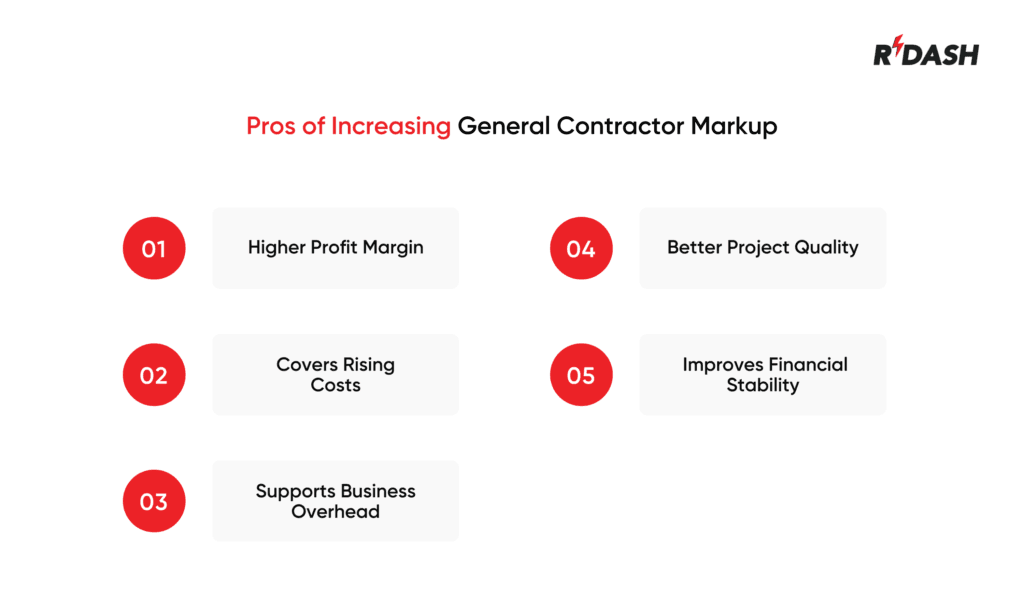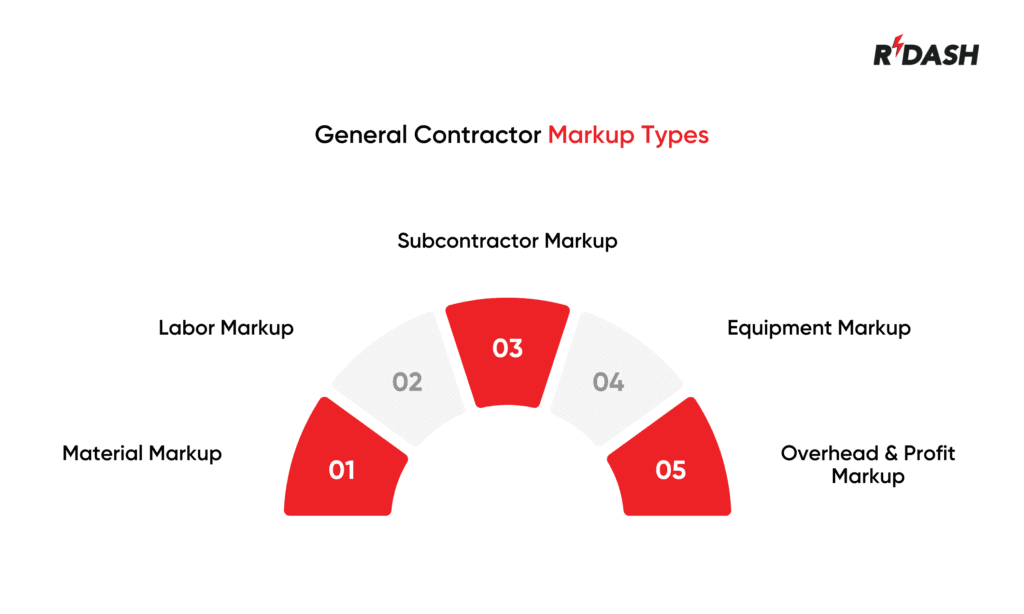What is general contractor markup?
General contractor markup is the extra percentage a contractor adds to the base cost of a construction project. This markup isn’t solely for profit; it also addresses various indirect business expenses not immediately linked to the actual construction activities.
When contractors undertake a project, they incur expenses for materials, workforce, machinery, and hiring specialized subcontractors. But they also have to pay for things like office expenses, staff salaries, licenses, insurance, transportation, and tools. These extra costs are part of running a business, even if they aren’t tied to one specific job. Markup is how contractors make sure all of these expenses are covered.
Markup also includes the contractor’s profit. Without a proper markup, a contractor may end up just covering costs without making any income for the company. That’s why markup is an essential part of estimating and pricing any construction project.
How to calculate your markup
To calculate your markup, follow these steps:
- To calculate your total costs, sum up the expenses for materials, labor, machinery, and any fees paid to subcontractors.
- Choose your markup percentage – Usually between 10% and 30%.
- Use the formula:
Selling Price = Total Cost × (1 + Markup Percentage)
Example:
If your total project cost is ₹1,00,000 and you want a 20% markup:
Selling Price = ₹1,00,000 × (1 + 0.20) = ₹1,20,000
This means you’ll charge ₹1,20,000 for the project.
What is the average markup for a builder?
Builders often add a markup to the actual cost of a project. This markup helps cover their business expenses and gives them profit. The average markup for a builder usually ranges between 10% and 30%, depending on the size and type of the project.
- For small residential jobs, the markup is often around 10% to 20%.
- For more substantial or intricate projects, the markup percentage might increase to between 25% and 30%..
The exact percentage can vary depending on:
- The builder’s overhead costs (like staff, office rent, tools, etc.)
- Project risks or special requirements
- Local market conditions and competition
Builders must choose a markup that covers all their costs and still keeps them competitive in the market.
Markup vs. Margin – what’s the difference?
While markup and margin might seem alike, they are distinct concepts. Here’s the simple difference:
What is Markup?
Markup is the amount added to the cost price to reach the selling price.
Formula:
Markup (%) = (Selling Price – Cost) ÷ Cost × 100
Example:
If a job costs ₹1,00,000 and the builder adds a 20% markup:
Selling Price = ₹1,00,000 × (1 + 0.20) = ₹1,20,000
What is Margin?
Margin refers to the profit percentage calculated from the selling price rather than the cost.
Formula:
Margin (%) = (Selling Price – Cost) ÷ Selling Price × 100
Using the same example:
Selling Price = ₹1,20,000
Cost = ₹1,00,000
Margin = ₹20,000 ÷ ₹1,20,000 × 100 = 16.67%
In Simple Terms:
- Markup is based on cost
- Margin is based on selling price
Even though both show how much profit is made, they give different percentages. It’s important for builders to know both to price their projects correctly and stay profitable.
Pros of increasing general contractor markup
Raising the markup can be a smart decision for general contractors, especially when done for the right reasons. Here are some key benefits:

1. Higher Profit Margins
Increasing the markup allows contractors to earn more from each project. This extra income helps support business growth, investments in better tools, or hiring skilled workers.
2. Covers Rising Costs
Material prices, fuel charges, and labor costs often go up over time. A higher markup helps cover these rising expenses without affecting the contractor’s profit.
3. Supports Business Overhead
As the business grows, so do the fixed costs – such as office rent, admin salaries, insurance, and software tools. A slightly higher markup helps manage these overheads with ease.
4. Improves Financial Stability
With better earnings from each job, contractors can build a cash reserve. This helps them handle delays in client payments or take on new projects without worrying about short-term cash flow.
5. Better Project Quality
More funds allow contractors to hire skilled workers, buy better materials, and manage work more effectively. This approach can result in fewer errors and more satisfied clients.
When should general contractors adjust their markup?
Adjusting the markup isn’t something to be done randomly. Here are situations when it makes sense:
1. Material and Labor Costs Have Increased
If suppliers raise prices or labor becomes more expensive, increasing the markup helps cover the new costs without reducing profits.
2. Projects Are More Complex
Challenging projects often come with higher risks. These may include tight timelines, difficult designs, or working with new teams. A higher markup gives room to handle unexpected problems.
3. You’re Offering More Value
If the contractor is now offering more services—like project tracking, safety checks, or faster delivery – they can justify a higher markup.
4. Market Demand Is High
When there’s a lot of demand and limited competition, clients are often willing to pay more for reliable contractors. This is a good time to raise the markup slightly.
5. To Stay Profitable
If profit margins are shrinking due to increasing expenses or delays, reviewing and adjusting the markup can help the business stay profitable.
General contractor markup types to consider
When pricing a project, general contractors use different types of markup to cover their costs and make a profit. Each type serves a specific purpose. Here are some common markup types contractors often include:

1. Material Markup
This is added on top of the cost of materials like cement, steel, tiles, or paint. It covers the effort of sourcing, transporting, and storing materials, and also includes a small profit.
2. Labor Markup
Labor markup covers wages paid to workers, along with benefits, insurance, and supervision. It guarantees that the contractor makes a profit beyond the labor costs.
3. Subcontractor Markup
If a contractor hires electricians, plumbers, or other specialists, they may add a markup on the subcontractor’s cost. This covers coordination effort and risk handling.
4. Equipment Markup
This includes the cost of renting or owning equipment used on-site, like cranes, generators, or mixers. The markup helps maintain or replace equipment over time.
5. Overhead and Profit Markup
This is a general markup that includes office expenses, staff salaries, insurance, licenses, and the contractor’s profit. It is typically applied as a percentage of the overall project cost.
Should clients be informed about the general contractor’s markup percentage?
This is a common question in construction. While some clients want full transparency, others focus more on the total project cost. Here’s what contractors should consider:
1. Depends on Contract Type
- In lump sum contracts, the client pays a set sum that already includes the markup.
- There’s no need to break it down.
- In cost-plus contracts, clients pay actual costs plus a fee or percentage. In this case, the markup should be clearly mentioned.
2. Builds Trust
Sharing the markup percentage can build trust with the client, especially in long-term or large projects. It shows honesty and helps clients understand how pricing works.
3. Avoids Misunderstandings
If clients discover the markup later without being informed, it may cause confusion or mistrust. Being open about it from the start avoids future problems.
4. Not Always Necessary
In many cases, clients are only interested in the final price and delivery timeline. If the contractor delivers quality work on time, clients may not question the breakdown.
FAQs
What is general contractor markup?
General contractor markup is the additional percentage added to the base project cost by contractors to cover indirect business expenses and profit, ensuring all costs are covered and the project remains profitable.
What is the difference between markup and margin?
Markup is the percentage added on top of costs to determine the selling price, while margin is the profit percentage based on the selling price. Both are important for pricing strategy and profitability analysis.
When should contractors adjust their markup?
Contractors should increase markup when project complexity rises, costs increase, added value is provided, demand is high, or profit margins decline.







